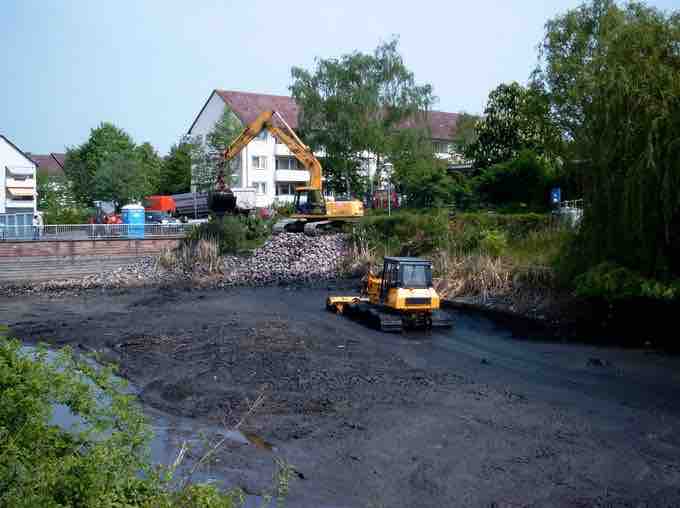Sulfate reduction is a type of anaerobic respiration that utilizes sulfate as a terminal electron acceptor in the electron transport chain. Compared to aerobic respiration, sulfate reduction is a relatively energetically poor process, though it is a vital mechanism for bacteria and archaea living in oxygen-depleted, sulfate-rich environments.
Many sulfate reducers are organotrophic, using carbon compounds, such as lactate and pyruvate (among many others) as electron donors, while others are lithotrophic, and use hydrogen gas (H2) as an electron donor. Some unusual autotrophic sulfate-reducing bacteria (e.g., Desulfotignum phosphitoxidans) can use phosphite (HPO3-) as an electron donor, whereas others (e.g., Desulfovibrio sulfodismutans, Desulfocapsa thiozymogenes, and Desulfocapsa sulfoexigens) are capable of sulfur disproportionation (splitting one compound into two different compounds, in this case an electron donor and an electron acceptor) using elemental sulfur (S0), sulfite (SO32−), and thiosulfate (S2O32−) to produce both hydrogen sulfide (H2S) and sulfate (SO42−).
Before sulfate can be used as an electron acceptor, it must be activated. This is done by the enzyme ATP-sulfurylase, which uses ATP and sulfate to create adenosine 5'-phosphosulfate (APS). APS is subsequently reduced to sulfite and AMP. Sulfite is then further reduced to sulfide, while AMP is turned into ADP using another molecule of ATP. The overall process, thus, involves an investment of two molecules of the energy carrier ATP, which must to be regained from the reduction.
All sulfate-reducing organisms are strict anaerobes. Because sulfate is energetically stable, it must be activated by adenylation to form APS (adenosine 5'-phosphosulfate) to form APS before it can be metabolized, thereby consuming ATP. The APS is then reduced by the enzyme APS reductase to form sulfite (SO32−) and AMP. In organisms that use carbon compounds as electron donors, the ATP consumed is accounted for by fermentation of the carbon substrate. The hydrogen produced during fermentation is actually what drives respiration during sulfate reduction.
Sulfate-reducing bacteria can be traced back to 3.5 billion years ago and are considered to be among the oldest forms of microorganisms, having contributed to the sulfur cycle soon after life emerged on Earth. Sulfate-reducing bacteria are common in anaerobic environments (such as seawater, sediment, and water rich in decaying organic material) where they aid in the degradation of organic materials. In these anaerobic environments, fermenting bacteria extract energy from large organic molecules; the resulting smaller compounds (such as organic acids and alcohols) are further oxidized by acetogens, methanogens, and the competing sulfate-reducing bacteria.
Many bacteria reduce small amounts of sulfates in order to synthesize sulfur-containing cell components; this is known as assimilatory sulfate reduction. By contrast, sulfate-reducing bacteria reduce sulfate in large amounts to obtain energy and expel the resulting sulfide as waste; this is known as "dissimilatory sulfate reduction. " Most sulfate-reducing bacteria can also reduce other oxidized inorganic sulfur compounds, such as sulfite, thiosulfate, or elemental sulfur (which is reduced to sulfide as hydrogen sulfide).
Toxic hydrogen sulfide is one waste product of sulfate-reducing bacteria; its rotten egg odor is often a marker for the presence of sulfate-reducing bacteria in nature. Sulfate-reducing bacteria are responsible for the sulfurous odors of salt marshes and mud flats. Much of the hydrogen sulfide will react with metal ions in the water to produce metal sulfides. These metal sulfides, such as ferrous sulfide (FeS), are insoluble and often black or brown, leading to the dark color of sludge. Thus, the black color of sludge on a pond is due to metal sulfides that result from the action of sulfate-reducing bacteria .

Black sludge
The black color of this pond is due to metal sulfides that result from the action of sulfate-reducing bacteria.
Some sulfate-reducing bacteria play a role in the anaerobic oxidation of methane (CH4 + SO42- → HCO3– + HS– + H2O). An important fraction of the methane formed by methanogens below the seabed is oxidized by sulfate-reducing bacteria in the transition zone separating the methanogenesis from the sulfate reduction activity in the sediments.This process is also considered a major sink for sulfate in marine sediments. In hydrofracturing fluids used to frack shale formations to recover methane (shale gas), biocide compounds are often added to water to inhibit the microbial activity of sulfate-reducing bacteria in order to avoid anaerobic methane oxidation and to minimize potential production loss.
Sulfate-reducing bacteria often create problems when metal structures are exposed to sulfate-containing water. The interaction of water and metal creates a layer of molecular hydrogen on the metal surface. Sulfate-reducing bacteria oxidize this hydrogen, creating hydrogen sulfide, which contributes to corrosion. Hydrogen sulfide from sulfate-reducing bacteria also plays a role in the biogenic sulfide corrosion of concrete, and sours crude oil.
Sulfate-reducing bacteria may be utilized for cleaning up contaminated soils; some species are able to reduce hydrocarbons, such as benzene, toluene, ethylbenzene, and xylene. Sulfate-reducing bacteria may also be a way to deal with acid mine waters .